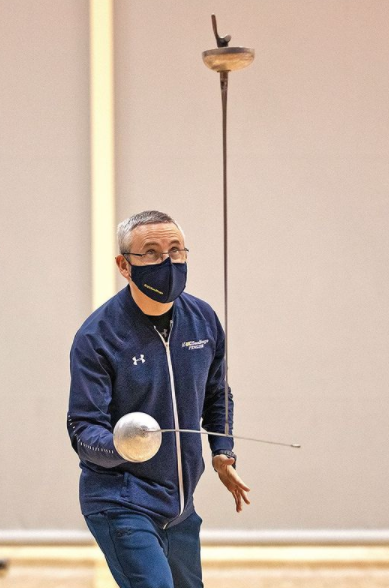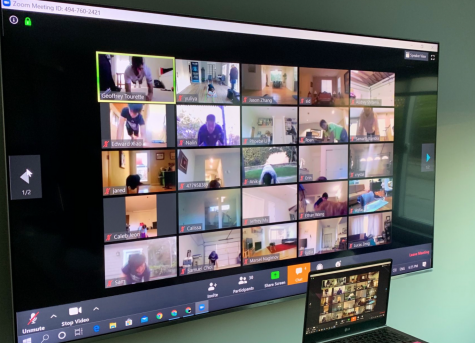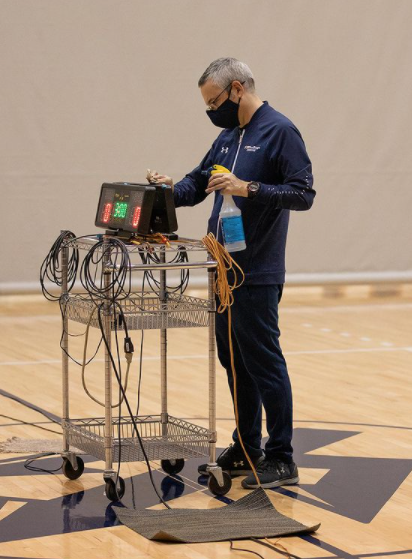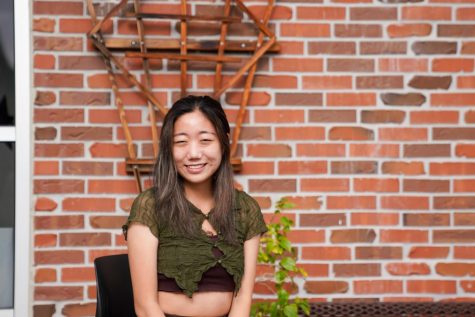Fencing during Covid-19
Fencers react to the new regulations for fencing practices and tournaments

UCSD coach, Juan Ignacio Calderon, practicing while masked. Photos from @ucsdfencing
December 5, 2020
Like many sports, fencing competitions and practices were shut down in March due to COVID-19. As a result, Anika Soin, a UC San Diego freshman and MVHS class of 2020 alumni, had to stop practicing at her club, Academy of Fencing Masters (AFM), for the following six months. Because this was the longest hiatus she had taken, Soin says that her strength and endurance suffered when she resumed fencing. Soin also notes that the lack of interaction with her clubmates impacted her mental health.

“[My teammates] are like my family,” Soin said. “When COVID hit, not being able to practice with those people like I would normally do daily changed a huge part of my life. Mentally, it was a little rough and I was a bit more lonely.”
Likewise, Samantha Hsiung, a sophomore at Pinewood High School in San Jose and fencer at Silicon Valley Fencing (SVF), experienced similar mental health effects. However, Hsiung shares that she was still able to stay active during quarantine due to her club hosting Zoom practices. Hsiung’s clubmate, sophomore Samuel Choi, notes that this break came with its own set of positives.
“I’ve actually enjoyed this type of lifestyle — just staying at home and working because I’ve been able to focus on academics a lot more,” Choi said. “I have more free time and I’ve been able to spend that time on things that I’m passionate about.”
When in-person practices resumed, the fencers were eager to return. Hsiung and Choi returned to SVF in July and September, respectively. Since Soin already graduated, she returned to in-person fencing at UCSD in September but emphasizes that there were heavy restrictions put in place.
Soin explains that athletes in UCSD are not allowed to exceed eight hours of affiliated athletics, which includes strength conditioning. Conditioning is open to all athletes but due to the need for constant sanitization, has to be equipmentless. Additionally, cones and boxes mark areas where masked athletes can train individually while maintaining their distance from one another. Despite these regulations, Soin was glad that she could begin exercising again.
“It’s still so restrictive,” Soin said. “But at the same time, I’d much rather that everyone is safe than risk it by going full on and starting regular fencing — that would be way too risky.”
Conditioning includes bodybuilding activities such as squats and abs but to improve her fencing, Soin also attends practices. Restrictions are again heavily emphasized here; between each sport, the chairs, scoring devices and even the floor are sanitized. Athletes are also tested for COVID-19 on a weekly basis and have to send their results to the athletic director within 72 hours. During fencing practice, each fencer is required to be masked and stay six feet apart, prohibiting all contact between athletes such as shaking hands.
“[In] fencing, there’s a lot of respect and honor, so after every bout, you’re supposed to salute your opponent and shake hands with them,” Soin said. “[Because of] COVID, we can’t do that, so we have to find new ways to show respect to each other.”
To make up for the lack of handshakes, Soin and her teammates tap their blades from six feet apart at the end of every bout. The regulations at UCSD are similar to the ones at SVF; fencers are required to sanitize regularly and wear a facemask underneath their fencing mask. Although the masks make it harder for Choi to breathe, he believes that it doesn’t hinder his practice. Both he and Hsiung agree that SVF is doing a good job enforcing these regulations, although Hsiung took more time to adapt.
“When I started going [to] practice, I would go up to shake my hand after the bout, then I realized that you don’t do that anymore,” Hsuing said. “And as time passed, I just forgot that we would have to shake hands after every single bout since I haven’t done it for so long.”
When cases began to drop in September, USA Fencing, the organization that hosts all fencing tournaments, began hosting smaller competitions. They enforced similar rules such as constant sanitization, staying six feet apart and no direct contact. In addition, the organization also restricted any sort of cheering or even speaking because of the potential for droplets from the mouth to spread germs. USA Fencing also stopped allowing coaches to coach in the first round of competitions to minimize the number of people in the building.
“Normally in fencing, you’ll find a lot of fencers celebrating getting a point by doing a little scream or comment,” Soin said. “So [now we have] to celebrate in different ways, more to [ourselves] … they’re doing everything they can do to make sure students and staff are safe, but the COVID situation is constantly changing and fluctuating [such as] the number of cases, so the school has to keep trying to adapt quickly … [and] there’s bound to be some delays and unknowns at each stage [so] I’m anxious to see what they come up with next.”


















